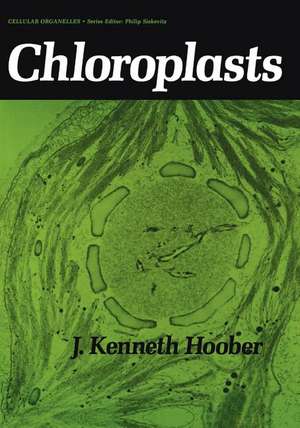Chloroplasts: Cellular Organelles
Autor J.K. Hooberen Limba Engleză Paperback – 31 aug 1984
Preț: 643.99 lei
Preț vechi: 757.63 lei
-15% Nou
Puncte Express: 966
Preț estimativ în valută:
123.23€ • 131.77$ • 102.74£
123.23€ • 131.77$ • 102.74£
Carte tipărită la comandă
Livrare economică 17 aprilie-01 mai
Preluare comenzi: 021 569.72.76
Specificații
ISBN-13: 9780306416866
ISBN-10: 0306416867
Pagini: 280
Ilustrații: XII, 280 p. 49 illus.
Dimensiuni: 178 x 254 x 16 mm
Greutate: 0.52 kg
Ediția:1984
Editura: Springer Us
Colecția Springer
Seria Cellular Organelles
Locul publicării:New York, NY, United States
ISBN-10: 0306416867
Pagini: 280
Ilustrații: XII, 280 p. 49 illus.
Dimensiuni: 178 x 254 x 16 mm
Greutate: 0.52 kg
Ediția:1984
Editura: Springer Us
Colecția Springer
Seria Cellular Organelles
Locul publicării:New York, NY, United States
Public țintă
ResearchCuprins
1 Historical Perspectives: The Beginnings of Research on Photosynthesis.- I. The Discovery of Chloroplasts.- II. Chemical Studies—The Development of Gas Chemistry.- III. The Phlogiston Theory.- IV. The Discovery of Photosynthesis.- V. Association of Photosynthesis with Chloroplasts.- VI. Development of a Major Research Tool—Isotopic Compounds.- VII. Summary.- Literature Cited.- Additional Reading.- 2 Structure of the Chloroplast.- I. Importance of the Membrane.- II. Structure of the Thylakoid Membrane.- III. Morphological Aspects of Photosynthetic Membranes.- IV. The Chloroplast Endoplasmic Reticulum and the Periplastidal Compartment.- V. Evolutionary Ontogeny of Chloroplast Structure.- VI. The Pyrenoid Body.- VII. Chloroplast Size and Number.- VIII. Summary.- Literature Cited.- Additional Reading.- 3 Characteristic Components of Chloroplast Membranes.- I. Purification of Chloroplasts.- II. Components of the Thylakoid Membrane.- III. Components of the Chloroplast Stroma.- IV. Summary.- Literature Cited.- Additional Reading.- 4 The Process of Photosynthesis: The Light Reactions.- I. Introduction.- II. Primary Mechanisms of Photosynthesis.- III. Chemical Currency.- IV. The Flow of Electrons during Photosynthesis.- V. Membrane-Bound Electron Carriers.- VI. Topographical Arrangement of Electron Carriers.- VII. Evidence for Two Photosystems.- VIII. An Alternate Proposal.- IX. Regulation of Energy Distribution from Light-Harvesting Complexes by Protein Phosphorylation.- X. Formation of ATP.- XI. The Chloroplast Coupling Factor (CF1).- XII. Electron Transport in Photosynthetic Bacteria.- Additional Reading.- 5 The Process of Photosynthesis: The Dark Reactions.- I. Introduction.- II. Fixation of CO2.- III. Requirement of CO2 for O2 Evolution.- IV. Inhibition of CO2 Fixationby O2: Photorespiration.- V. Assimilation of Nitrogen and Sulfur.- VI. Summary for Chapters 4 and 5.- Literature Cited.- Additional Reading.- 6 The Chloroplast Genome and Its Expression.- I. Introduction.- 147II. Purification of Chloroplast DNA.- III. Chloroplast DNA Molecules Are Identical.- IV. Synthesis of Chloroplast DNA.- V. Inheritance of Chloroplast DNA.- VI. Expression of Chloroplast Genetic Information.- VII. Why Chloroplast DNA?.- VIII. Protein Synthesis.- IX. Association of Ribosomes with Membranes.- X. Summary.- Literature Cited.- Additional Reading.- 7 Development of Chloroplasts: Structure and Function.- I. Introduction.- II. Etiolation of Chloroplasts.- III. Morphology of Chloroplast Development.- IV. Site of Assembly of Thylakoid Membranes.- V. Chloroplast Development and the Chloroplast Endoplasmic Reticulum.- VI. Chromatophore Development in Photosynthetic Bacteria.- VII. Development of Function.- VIII. Development of Photosynthetic Units.- Additional Reading.- 8 Development of Chloroplasts: Biosynthetic Pathways and Regulation.- I. Introduction.- II. Chlorophyll.- III. Lipids.- IV. Synthesis of Chloroplast Proteins.- V. How Are Polypeptides Taken up by Chloroplasts?.- VI. Processing of Incoming Chloroplast Proteins.- VII. Source of Chloroplast Proteins—A Summary.- VIII. Light and Chloroplast Development.- IX. Symmary.- Literature Cited.- Additional Reading.- 9 Evolutionary Aspects of Chloroplast Development.- I. Evolutionary History of Chloroplasts.- II. Chloroplasts Resemble Prokaryotic Cells.- III. Development of Phylogenetic Trees.- IV. Was DNA Transferred from Chloroplast to Nucleus?.- V. Development of Photosynthetic Systems.- VI. Summary.- Literature Cited.- Additional Reading.



















